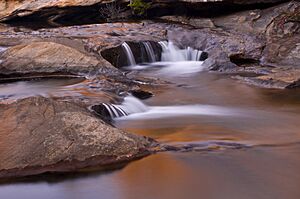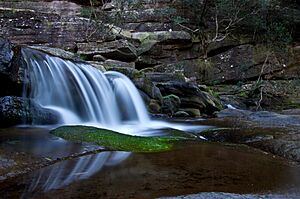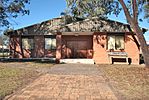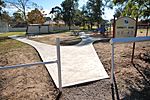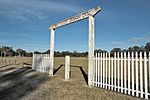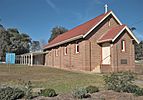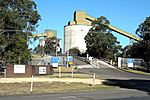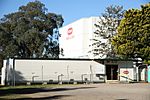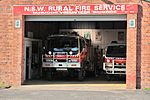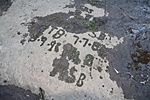Tahmoor, New South Wales facts for kids
Quick facts for kids TahmoorNew South Wales |
|||||||||||||||
|---|---|---|---|---|---|---|---|---|---|---|---|---|---|---|---|
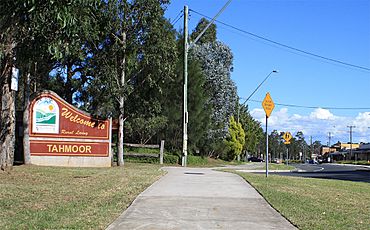 |
|||||||||||||||
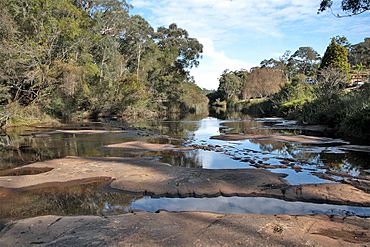
Bargo River, original crossing place south of Tahmoor
|
|||||||||||||||
| Population | 5,067 (2016 census) | ||||||||||||||
| Postcode(s) | 2573 | ||||||||||||||
| Elevation | 275 m (902 ft) | ||||||||||||||
| Location |
|
||||||||||||||
| LGA(s) | Wollondilly Shire | ||||||||||||||
| Region | Macarthur | ||||||||||||||
| State electorate(s) | Wollondilly | ||||||||||||||
| Federal Division(s) | Hume | ||||||||||||||
|
|||||||||||||||
Tahmoor is a friendly town in the Macarthur Region of New South Wales, Australia. It's part of the Wollondilly Shire and is known for its natural beauty and community spirit.
Contents
History of Tahmoor
Tahmoor was first known as Myrtle Creek. It was a farming area located along the Great Southern Road, which later became the Hume Highway.
How Tahmoor Got Its Name
In 1919, a new railway line opened, and a station was built here. It was named Tahmoor. A local businessman wanted to call the town Bronzewing Park, but his idea was not chosen. The name "Tahmoor" comes from a local Aboriginal word for the common bronzewing (Phaps chalcoptera). This is a type of native pigeon that was often seen in the area.
The Challenging Bargo River Crossing
The Bargo River flows just south of Tahmoor. Crossing the Bargo River on the old Great South Road used to be very difficult for travellers. It caused many delays and accidents. This challenging crossing even became famous in Australian stories and songs, like "Stringybark and Greenhide".
The thick, uncleared bushland on the other side of the river was called the Bargo Brush. People were often scared of this area because it was known as a hiding place for escaped convicts who became bushrangers. The road through the Bargo Brush was often almost impossible to travel on. People described it as full of deep pits and muddy bogs.
Over time, more farmers needed a safer way to send their produce to nearby railheads. This led to the building of a road bridge in 1898. The Main South Line was also moved in 1919 to pass through Tahmoor, making travel and transport much easier.
Heritage Sites in Tahmoor
Tahmoor has some special places that are protected because of their history. These are called heritage-listed sites. One important site is:
- Main Southern railway: Tahmoor railway station
Tahmoor Today
In 2016, Tahmoor had a population of 5,067 people. This included 227 Indigenous Australians and 4,074 people who were born in Australia.
Shopping and Services
Tahmoor and nearby Picton are planned to be the main shopping and service centres for the Wollondilly Shire. Tahmoor has three large supermarkets. Two of these are in separate shopping centres: the older Tahmoor Shopping Village and the newer Tahmoor Town Centre. You can also find many small businesses, a growing medical and dental centre, and several places to grab a quick meal or enjoy a restaurant. Tahmoor has a Chamber of Commerce, which helps support projects in the community.
Schools in Tahmoor
For younger students, there's Tahmoor Public School, which teaches children from Kindergarten to Year 6. It also has a special needs department. For older students, Wollondilly Anglican College is an independent school that teaches students from Kindergarten all the way to Year 12. Many secondary students also go to Picton High School nearby or other schools in the region.
Jobs and Transport
The Tahmoor Colliery, a coal mine located south in North Bargo, is a big employer for people in Tahmoor and the surrounding areas. Ingham's Enterprises, a company that processes poultry, also provides many jobs. The supermarkets and small shops in town also employ many people, especially for part-time and casual roles.
Tahmoor railway station is part of the Southern Highlands Line, making it easy to travel by train. Local bus services are also available.
Community Life
Tahmoor has great facilities for sports, including sporting fields and a skate and BMX park. The Country Women's Association owns a community hall that can be used for events. The Rural Fire Service, which helps fight bushfires, also has its station here. The original fire station was an old hay shed that was donated. With help from donations, the brigade has improved its facilities a lot over the years.
The official soccer team for Tahmoor is called the Tahmoor Taipans. They play in the Macarthur District Soccer Football Association League. Their home ground is Tahmoor Oval.
Places of Worship
Tahmoor has several churches, including Catholic, Uniting, Seventh-day Adventist, and Anglican churches. South of the town, you'll find the Kiah Ridge Conference Centre, which is run by the Baptist Church.
Bushwalking Adventures
If you love exploring nature, Tahmoor has some great bushwalking trails. These tracks start from the Potholes Reserve. You can walk to beautiful spots like Mermaid Pools, See Through Pools, Bargo Falls, the Rapids on the Bargo River, and Tahmoor Gorge. It's even possible to trek downstream all the way to the Nepean River.
Tahmoor gallery
- Images of Tahmoor today
-
C. W. A. Community Hall -
Holy Trinity Anglican Church



